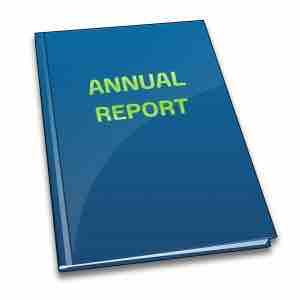Recognition of Accounts Receivables
If you are operating under the accrual basis, you record transactions irrespective of any changes in cash. This is the system under which you record an account receivable. In addition, there is a risk that the customer will not pay you. If so, you can either charge these losses to expense when they occur, known as the direct write-off method, or you can anticipate the amount of such losses and charge an estimated amount to expense, known as the allowance method .

Using the Balance Sheet
The balance sheet is one of the financial reports included in a company's annual report.
Booking a receivable is accomplished by a simple accounting transaction. However, the process of maintaining and collecting payments on the accounts receivable is more complex. Depending on the industry in practice, accounts receivable payments can be received up to 10 – 15 days after the due date has been reached. These types of payment practices are sometimes developed by industry standards, corporate policy, or because of the financial condition of the client.
Account receivables are classified as current assets assuming that they are due within one year. To record a journal entry for a sale on account, one must debit a receivable and credit a revenue account. When the customer pays off their accounts, one debits cash and credits the receivable in the journal entry. The ending balance on the trial balance sheet for accounts receivable is always debit.
Payment Terms
An example of a common payment term is Net 30, which means that payment is due at the end of 30 days from the date of invoice. The debtor is free to pay before the due date; businesses can offer a discount for early payment. Other common payment terms include Net 45, Net 60, and 30 days end of month.
Allowance for Doubtful Accounts
Since not all customer debts will be collected, businesses typically estimate the amount of and then record an allowance for doubtful accounts which appears on the balance sheet as a contra account that offsets total accounts receivable. Two methods are available to calculate the amount of bad debt expense and allowance of doubtful accounts at the end of an accounting period -- percentage of accounts receivable or percentage of sales. When accounts receivables are not paid, some companies turn them over to third party collection agencies or collection attorneys who will attempt to recover the debt via negotiating payment plans, settlement offers or pursuing other legal action.
Examples of Allowance Calculation
An example of how to calculate the allowance for doubtful accounts using the percentage of receivables method -- Assume Furniture Palace has an ending accounts receivable balance of USD 10,000 and estimates that 5% of receivables are doubtful. To adjust the allowance account for the new estimate, debit Bad Debt Expense for USD 500 (10,000 *0.05) and credit Allowance for Doubtful Accounts for USD 500.
To calculate the allowance for doubtful accounts using the percentage of total sales, estimate the percentage of sales that will be uncollectible. Furniture Palace estimates that 10% of the period's USD 20,000 total sales may not be collected. To adjust the allowance account for the new period's estimate, debit Bad Debt Expense for USD 2,000 (20,000 *0.10) and credit Allowance for Doubtful Accounts for USD 2,000.